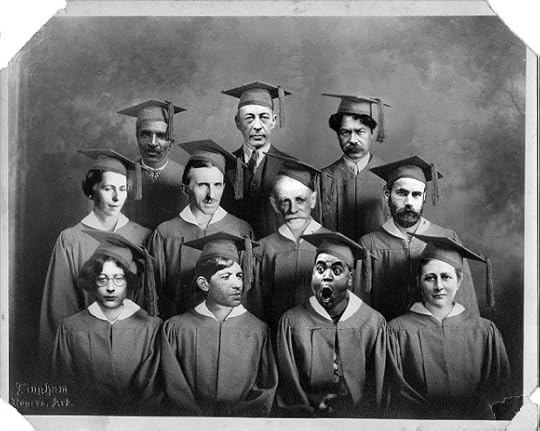Andrew Sullivan's Blog, page 393
January 2, 2014
How To Repel Tourism
Looking at 188 countries around the world, [Robert] Lawson and [Saurav] Roychoudhury examined which ones require people to apply for a visa before they visit. Then they studied how many tourists travel from one country to another. Allowing for factors such as population, income, the size of bilateral trade, economic policies, a measure of democracy, and an indicator of world-class sites of cultural importance, they found that tougher visa requirements imposed on potential visitors from a given country are associated with considerably less tourism from that country. In short: Demanding a visa from a country’s travelers in advance is associated with a 70 percent lower level of tourist entries than from a similar country where there is no visa requirement. The U.S. requires an advance visa from citizens of 81 percent of the world’s countries; if it waived that requirement, the researchers estimate, inbound tourism arrivals would more than double, and tourism expenditure would climb by $123 billion.
This may seem trivial, but it isn’t with respect to American soft power. Most Dishheads are American citizens, so they don’t fully see what it is like to enter the US as a non-citizen. It’s a grueling, off-putting, frightening, and often brutal process. Compared with entering a European country, it’s like entering a police state. When you add the sheer difficulty of getting a visa, the brusque, rude and contemptuous treatment you routinely get from immigration officials at the border, the sense that all visitors are criminals and potential terrorists unless proven otherwise, the US remains one of the most unpleasant places for anyone in the world to try and get access to.
And this, of course, is a function not only of a vast and all-powerful bureaucracy. It’s a function of this country’s paranoia and increasing insularity. It’s a thoroughly democratic decision to keep foreigners out as much as possible. And it’s getting worse and worse. Since I first came here in 1984, it’s a different world. Clinton’s 1996 law made matters far worse; 9/11 did the rest; and the Obama administration hasn’t changed much of anything.



Hold The Mayo
While documenting the history of the anti-mayonnaise movement, David Merritt Johns considers the nature of taste and revulsion:
Mayonnaise contains an animal product, it is reminiscent of pus or semen, and it is remarkably slimy and jiggly. … But vanilla ice cream and pudding are also jizzlike slimes, and they arouse little animus; ketchup is cherished despite its likeness to blood. And scholars have long noted that revulsion can rarely be reduced to sensory factors alone. Charles Darwin commented on the social aspects of taste in his 1872 The Expression of the Emotions in Man and Animals: “In Tierra del Fuego a native touched with his finger some cold preserved meat which I was eating at our bivouac, and plainly showed utter disgust at its softness; whilst I felt utter disgust at my food being touched by a naked savage, though his hands did not appear dirty.”
Darwin’s observations hinted at an idea upon which revulsion scholars generally agree: Disgust is largely a cultural phenomenon. Infants don’t seem to experience it. Tiny children will tolerate unholy decay odors, and experiments show many will happily eat imitation feces (made with stinky cheese) or quaff glasses of juice in which (sterilized) grasshoppers bob like ice cubes. From centipedes to boogers, the grossout response is a learned one. Its latent purpose is often to distinguish friend from foe, and pass judgment on the habits of others. (To wit: As one informant bluntly told me, “Let’s be honest: Mayonnaise is a fat man’s food.” …



Journalism And Power
In an excerpt from his new book, The Watchdog That Didn’t Bark, Dean Starkman contrasts accountability journalism with access journalism. Perhaps the best way to distinguish between the two is that one form of journalism seeks access to power and the other kind of journalism seeks to make power uncomfortable. We all know which one is losing. Mike Allen loves the powerful and does all he can to broadcast their messages and stroke their egos. He is the icon of the new era of court stenographers masquerading as journalists. But if you’re looking for a journalism that holds the powerful accountable, you’ll have to look outside their circle of supine friends and suck-ups.
CJR’s editors chime in:
This debate is not about the use of hot words, like “torture.” It’s about whether journalism perceives as its core mission holding power to account. If it doesn’t, then the DealBooks and Playbooks of the world will always win the day. If it does, then the access-accountability polarity should be the defining measure of journalism’s merits.
Oh, for the days of disreputable hacks. No media elite dinners for them.



A Smaller, Broader Federalism
This map, created by geography professor Andrew Shears in 2011, has been making the rounds. It imagines the US if its various secession movements, partition proposals, and other attempts to redraw state boundaries throughout our history had succeeded. Ozimek imagines the economic advantages of having 124 states instead of 50:
1. Competition between the states be higher as more people would be able to move to a different state and accompanying state government by moving much less distance, e.g. a lower cost of switching.
2. There would be more experimentation, and thus perhaps a greater ability to learn more about which policies work and which don’t.
3. The ability to redistribute would be lower, given point #1 above.
4. It would be easier in some places to redistribute since a larger number of states allows for more self-sorting into politically homogeneous states.
On a related note, Michael Greve makes the case for a strong contrast between red and blue states:
[T]he right, “competitive” kind of federalism requires a certain degree of polarization (or sectionalism). And the price may well be worth paying. Consider a few well-understood but underestimated advantages:
Competitive federalism reveals information. We can debate the abstract advantages of “red” or “blue,” “American” and “European” social models until the cows come home: there’s no substitute for observing the actual effects in real life.
Competitive federalism satisfies preferences. A thoroughly blue or red United States would leave one half of the country very unhappy. That’s not true under federalism—not when preferences are heterogeneous across states and (relatively) homogeneous within states. As, increasingly, now.
Competitive federalism reveals preferences and reduces ignorance. People move across states lines in response to a ton of factors (climate, jobs, housing costs…)—many of which are policy-dependent. “Foot-voting” is a pretty good political feed-back mechanism: sooner or later, (state) politicians will pay attention. And as my colleague Ilya Somin has argued in a recent book, there’s no incentive to cast an informed vote for the House, Senate or President; so people vote in near-total ignorance. They don’t vote that way with their feet, for obvious reasons.You can’t have those sweet advantages without the bitter; the trick is to minimize the costs.



Did Bush Know About Torture?
In his 2010 memoir, the ex-president boasted of being a war criminal. Yet former CIA top lawyer John Rizzo’s new memoir says precisely the opposite. If Rizzo is right, as Marcy Wheeler notes, the entire program was illegal.



I’m A Low-Turnout Centrist Republican
Well, since I have a couple more years till I can vote, “no-turnout” would be more appropriate. But otherwise, I fit the classic political profile of a Jagermeister drinker.



Obamacare Arrives
Kliff heralds the dawn of the Obamacare era:
The next Obamacare fight is going to be about access. After three months of enrollment, January will be the first month when shoppers can see what they purchased. We know that the plans for sale on the marketplace tend to have relatively limited networks, as insurers restricted doctor access to hold down premium prices. New subscribers could find that a doctor they want isn’t in network, and get frustrated. Co-payments may seem alarmingly high — a byproduct of keeping premiums low. While the health-care system probably has the capacity to absorb a few million new insurance subscribers … there is still room for issues about access to specific doctors and the price tag that comes along with trips to the doctor’s office.
Kate Pickert also focuses on limited networks:
A recent study suggests limited provider networks could become more common in the years ahead as the ACA takes hold. A Dec. 13 McKinsey study of 20 U.S. metropolitan areas found that two-thirds of ACA plans analyzed had “narrow” or “ultra narrow” networks, with at least 30 percent of top 20 hospitals excluded for coverage. The medium premium for plans with narrower networks, according to the study, was 26 percent lower than comparable benefit packages with broad networks.
Cohn asked various health care wonks to make predictions about how the ACA will fare this year. Here’s Sean Parnell, author of The Self-Pay Patient, who is among the more pessimistic:
The biggest hurdle will be enrollment, particularly among the young and healthy. Deductibles are high, premium subsidies generally aren’t available except to the poorest, the tax for being uninsured is low, and the young have always been overrepresented among the uninsured. This will continue to be the case in 2014 and beyond.
Late in 2014, insurers will announce premiums for 2015. They will be higher, inflicting a political price on Democrats. Expect more creative interpretations and regulatory flexibility out of the Obama administration in order to smooth over more unintended consequences of the ACA.
There will be more Americans who pay directly for more of their health care. The ACA is projected by the Congressional Budget Office to leave 30 million people uninsured, and tens of millions more will get high-deductible plans through exchanges or their employers. These self-pay patients will demand price transparency and discounts for paying in full at the time of treatment, and innovative entrepreneurs will step up to cater to them while ignoring the traditional third-party payment system.
At the end of 2014, I expect to see many advocates of the ACA look back and conclude that while it’s too early to call the law a failure, the meager results fall far short of what was hoped for.



The View From Your Window
Chicago, Illinois, 4.16 pm.
Below is a much more striking wintry scene captured in the Windy City yesterday (but it’s not a true VFYW because the window frame isn’t visible):
Update from a reader:
The view of the ice breaking on the Chicago river also includes the abandoned foundation for the Calatrava Chicago Spire (the circular hole in the ground in the top right of the frame), a building that if it had been built, would have been indubitably the tallest in the Western Hemisphere. Thus, this photo could qualify for a view from your recession because it would have been built but for the financing drying up in the recession.



January 1, 2014
Happy Public Domain Day!
Each January 1, thousands of works are released into the public domain. The Public Domain Review honors the “Class of 2014″ (pictured above):
As usual it’s an eclectic bunch who have assembled for our graduation photo – including two very different geniuses of the piano, a French mystic, the creator of Peter Rabbit, one of the 20th century’s most important inventors, a poet who penned the Olympic Hymn, and a man known as the “Black Leonardo” who pretty much single-handedly created the peanut industry. The unifying factor bringing them all together is that all died in the year of 1943, and so their works, in many places, will be given a new lease of life as they pass into the public domain.
But instead of celebrating, some are mourning what would have entered the public domain on January 1, 2014, had we retained copyright laws from 1976. Duke University has assembled a list of such works, including Keroauc’s On the Road, Ayn Rand’s Atlas Shrugged, and Dr. Suess’s The Cat in the Hat. Citing Duke’s list, Adi Robertson zooms out:
The arguably bigger problem … involves books, films, and music that most people have never heard of, and that copyright holders aren’t going to bother preserving or reissuing — without a meaningful public domain, they can’t be archived in a way that makes them available to more than a privileged few.
(Image from The Public Domain Review. Top Row (left to right): George Washington Carver; Sergei Rachmaninoff; Shaul Tchernichovsky; Middle Row (left to right): Sophie Taeuber-Arp; Nikola Tesla; Kostis Palamas; Max Wertheimer; Bottom Row (left to right): Simone Weil; Chaim Soutine; Fats Waller; Beatrix Potter.)



Taking Anonymity Off The Menu
Long-time New York restaurant critic finally reveals to readers his identity: Adam Platt. He calls the pretense of anonymity a “dated charade” since restaurants typically know who the “anonymous” food critics are:
Why do I (with the prodding and endorsement of my editors) choose this particular moment to come lumbering into public view? A better question might be “What took you so goddamned long?” Dining critics in London began running their photos above their columns some time ago, and several of New York City’s most reputable critics have been out of the proverbial closet for years. Craig Claiborne, who helped invent the myth of the discreetly “anonymous” critic at the Times, used to have promising chefs, like Daniel Boulud, come and cook for him outside of their restaurants. During my lunch with [former New York magazine critic] Gael [Greene], Alain Ducasse emerged from his kitchen to give her a warm greeting, a dramatic gesture that did not prevent her from gleefully slamming his restaurant in a blistering cover-story review.
Over the years, this myth of anonymity has served many useful purposes. It’s worked, in practice, for the mysterious Michelin inspectors, who return to dining establishments year after year to take away or bestow their stars. It can work, also, for local critics whose publications attempt to cultivate a similar illusion of omniscience, although it’s been my experience that the handful of grand restaurants that actually have stars to lose will make it their business to spot you. Mostly, though, anonymity has been a powerful marketing tool. It’s lent a sense of impartiality and Oz-like mystery to the dark art of restaurant criticism, and if members of the clubby fine-dining world didn’t always believe it, then at least the public sometimes did.
Even though Platt has gone public, he will “continue to book restaurant tables at odd hours, under a string of ridiculously random made-up names, because more than a wig or a set of false whiskers, the art of surprise has always been the critic’s most useful tool.”



Andrew Sullivan's Blog
- Andrew Sullivan's profile
- 153 followers







